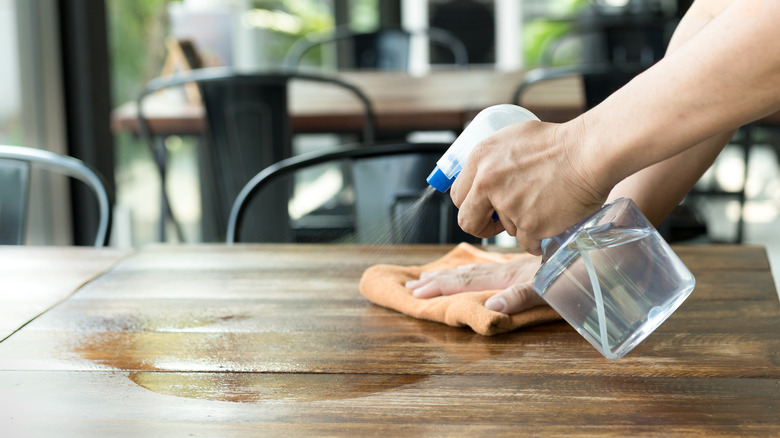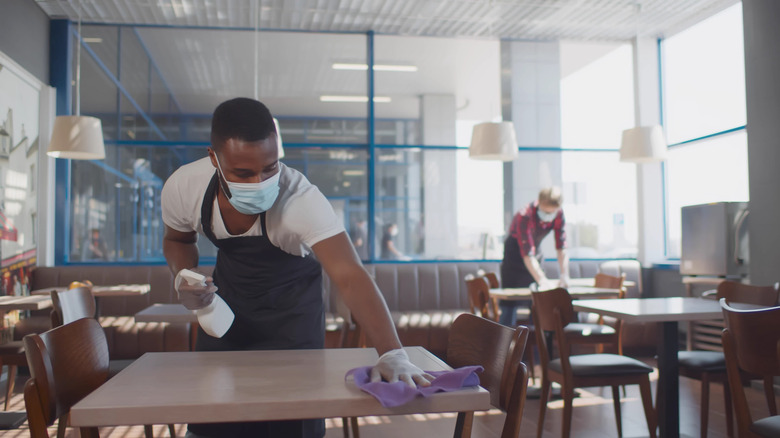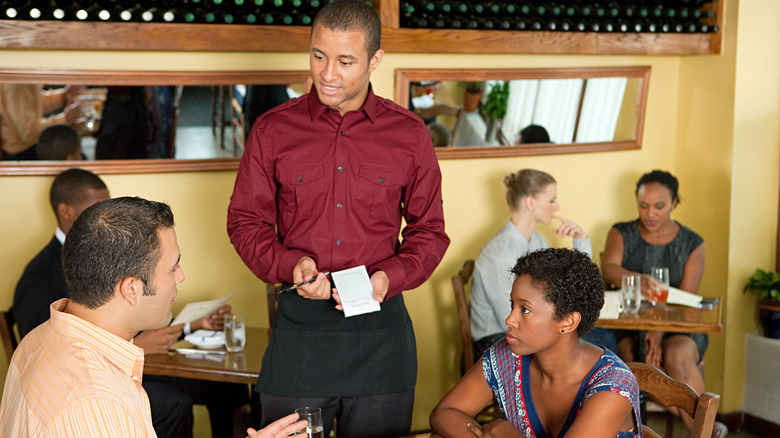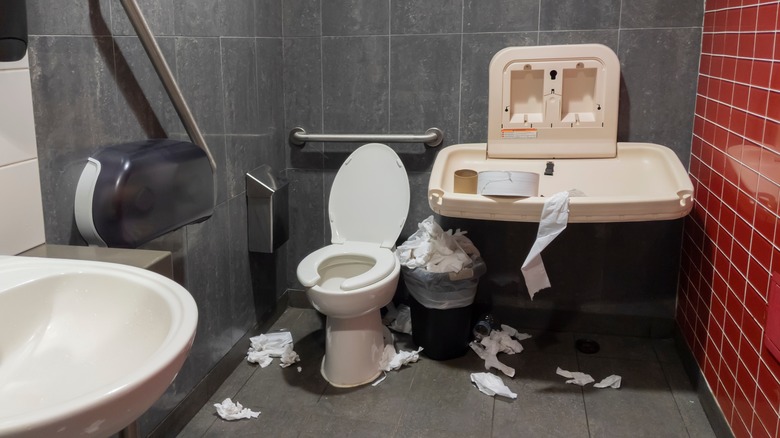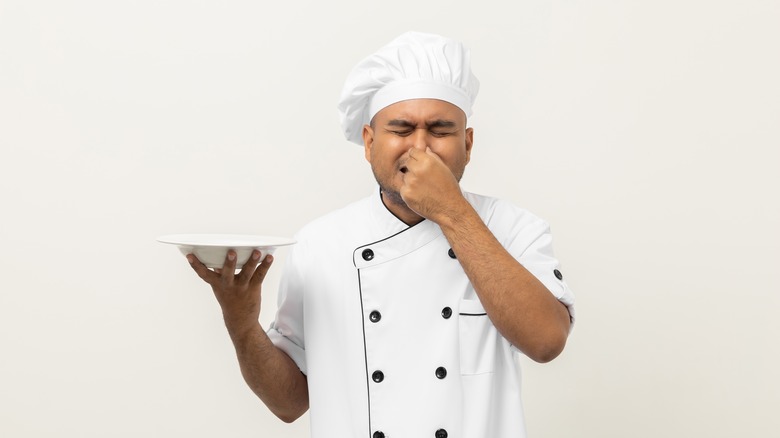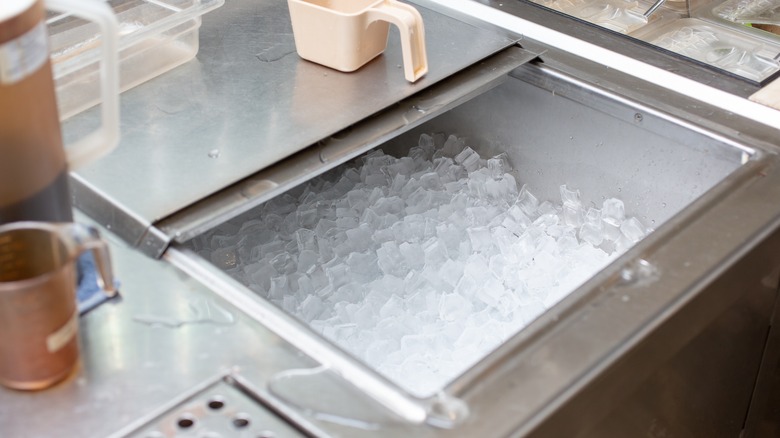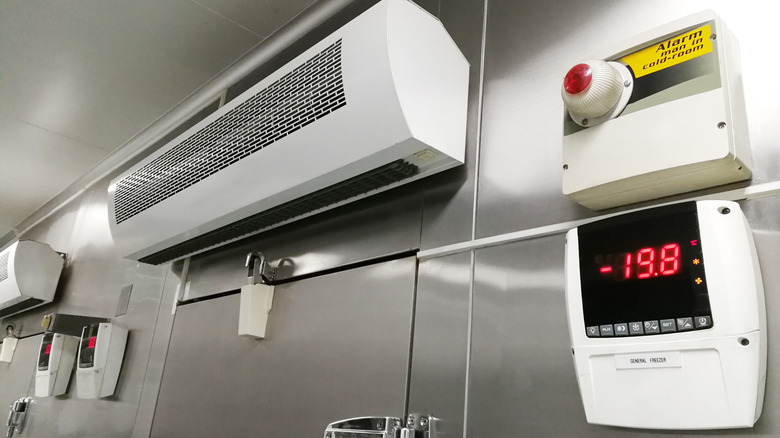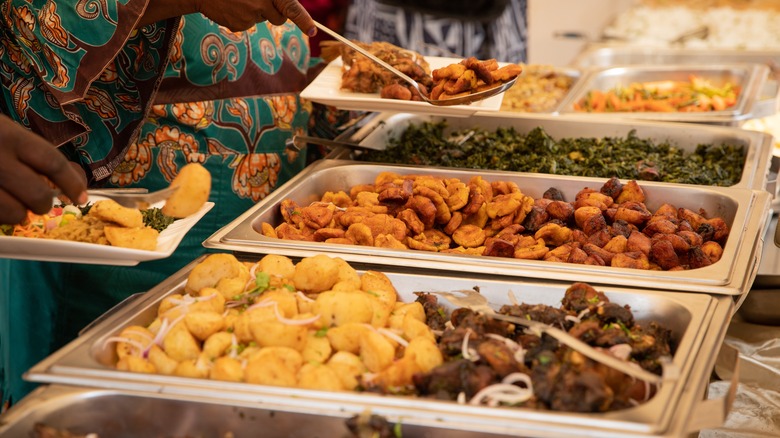12 Red Flags Restaurant Health Inspectors Always Look For
Almost all restaurant-goers would say cleanliness is a crucial factor when it comes to choosing where they eat. In a survey by Checkit, more than one-third of people questioned said they wouldn't go back to a restaurant with bad hygiene, and 75% of them said they'd never return if they found out someone got food poisoning (via Restaurant Online).
Although people tend to agree, unfortunately, most signs of bad restaurant hygiene aren't that easy to spot. The general public doesn't really know what to look out for unless a cockroach is literally staring them in the face. Thankfully, the heroic forces of restaurant health inspectors are hard at work making sure establishments are up to code when it comes to a clean, sanitary environment.
But is your favorite burger joint down the street up to code? How would you ever know? We reached out to health inspectors and sanitation experts to find out their biggest restaurant red flags. Keep reading to learn more — but be forewarned, you might not be able to unsee what you read.
1. Unmarked bottles are sketchy
The only thing sketchier than an unmarked bottle in the kitchen is one with a skull and crossbones. Unlabeled bottles can be a huge food safety hazard for (seemingly) obvious reasons. Angela Anandappa, the founding executive director of the nonprofit Alliance for Advanced Sanitation, spoke with Mashed and agrees that unmarked bottles are a huge red flag.
The contents should be clearly labeled, as well as the date it was filled up and when it should be discarded. If they aren't, they can be mixed up with cleaning products or maintenance items, which can be a huge health risk. You definitely don't want glass cleaner accidentally getting into your chimichurri.
It's not just the bottles, either. Labeling every food ingredient that goes into the dishes on the menu is essential. According to Johna Burdeos, a seasoned dietitian who has spent more than 20 years auditing kitchens in healthcare facilities, "All food items must be properly labeled with the correct date and time of preparation to ensure freshness and prevent the consumption of expired or spoiled food."
Restaurants are incredibly fast-paced environments that can get chaotic quickly. If workers don't know exactly what everything is, it could spell disaster.
2. Jewelry only looks good on the surface
Jewelry might be a sign of beauty and wealth — but not in the kitchen. Seeing people wearing jewelry can be a major red flag for a number of reasons. The first and most obvious is that workers can't wash their hands properly if they have rings on their fingers. That very same jewelry can come into contact with bodily fluids, which means plenty more chances for bacteria to grow. Most likely, the person wearing the jewelry never sanitizes it sufficiently for food service standards. Not to mention, it can tear right through gloves.
According to the U.S. Food & Drug Administration (FDA) Food Code, the only kind of arm jewelry a food worker can wear is a plain ring such as a wedding band, because it doesn't have any extra grooves where sneaky pathogens can hide. Other items, such as watches, bracelets, rings with jagged edges, or even medical alert bracelets should not be worn.
There's also the risk of freak accidents happening, like jewelry dropping into food and causing contamination, or even getting stuck in moving machinery, causing serious injury to the worker. If you see a food service worker wearing a beautiful watch, it might be time to find a new place to eat at. Anandappa also keeps a steady eye out for fake fingernails, which she says can be a big source of contamination — especially if they happen to fall into a big pot of soup.
3. Skeleton staffing is scary
The pandemic was a once in a lifetime disaster that wreaked havoc on just about every industry, but especially in food service. As of 2022, there were still more than 633,000 job openings in the food and accommodations industry. In other words, two in three restaurants were still understaffed (via National Restaurant Association). Not only has this shortage caused stress for other restaurant workers and their managers, but health inspectors aren't a fan of it, either.
Johna Burdeos says, "Insufficient staffing in a restaurant is a cause for concern to inspectors, as it may indicate employees are resorting to shortcuts to complete their tasks. The situation could lead to an increased risk of unsafe working conditions and the serving of unsafe food. This can also lead to low morale and high employee turnover. When you keep training new staff or have difficulty keeping staff on board, there's potential for more errors on the job."
She goes on to list several signs that could hint the establishment you're eating at doesn't have enough help. First, if you notice there are several dirty tables that haven't been cleaned after customers leave, it probably means there aren't enough employees. Another sign of skeleton staffing is a long wait time for your food — especially if it isn't a peak day or hour for the restaurant. If you walk in and no one greets you wihin five minutes, it might be time to go elsewhere.
4. Hardworking employees aren't always a good thing
In the U.S., we usually celebrate workers who go above and beyond in their work, but when it comes to restaurants, it could be a red flag. If you see employees frantically multitasking to get 10 things done at a time, it could be yet another sign of understaffing.
When you have the same person welcoming and seating guests, taking orders, cleaning tables, delivering food, and managing hundreds of other little tasks — all during a busy lunch rush — chances are a few things are going to slip between the cracks. They might forget to disinfect the host station, thoroughly mop the kitchen, or even skip over the bathroom altogether.
Burdeos includes managers in this category, too. "Managers may occasionally step in to do employee work during really busy times. But if you notice this is happening regularly at a restaurant you frequent, it's a red flag. Why can't they get adequate staffing? Is the place a poor working environment? You start to wonder what kinds of shortcuts the staff is taking that may compromise food safety and quality."
5. Unhappy staff = Unclean restaurants
Anandappa makes the important point that "Unhappy staff is never a good sign." There are several factors that can lead to low morale at restaurants, like lack of training, stress, bad management, high turnover, understaffing, pay issues, and personality clashes. Not only do unhappy employees lead to a loss of productivity and ultimately finances for the company, but health inspectors view this atmosphere as bad news.
In a viral AskReddit thread about restaurant red flags, one former manager said, "How happy is the staff? Do they seem like they like their jobs? If the staff are miserable, you're not going to get quality food or service. It's worth seeking out restaurants that treat their staff well. If they're treated well, they'll treat you well."
Sure, it's normal for workers to have a bad day once in a while. But it's one thing to have a bad day, and another to look like they don't care an ounce what happens to the restaurant and its diners. And if the front-of-house staff don't look like they care, who knows what's going on in the back of house? That's not a situation you want to be in when you're trusting cooks to prepare the food you're about to put into your body.
6. You can tell a lot by the menu
In a viral TikTok, a restaurant health inspector points out where she'll never eat — places with overly large menus. She goes on to say if a place has a big menu, it could be a sign of "lots of cheap, frozen food." Another Redditor confirms this in a thread about restaurant red flags, noting that not only are most of the items on that big ol' menu probably frozen, but it's also much harder to train employees to be good at making 40 different things. Ultimately, the quality of the food will likely suffer as well.
Chris Boyles, Vice President of Food Safety for Steritech, takes menu analysis one step further. If he sees certain items that require a heavy amount of manual prep and a kitchen that doesn't have the space, staff, or equipment to support it, it's a big red flag. If the restaurant doesn't have the appropriate setup, there's a big chance it's sacrificing quality and cleanliness in other ways.
Lastly, if the menu sticks to your fingers like a radioactive spider just bit you, it's definitely not a good sign. Keeping a heavily-used item like the menu clean is a rudimentary task that should be done regularly. If employees aren't keeping them clean ... who knows what else they're not taking care of.
7. Nobody likes a dirty bathroom
Speaking of obvious red flags, checking the bathroom is a pretty solid indicator of how much the restaurant staff cares about general cleanliness. It was consistently among the first warnings mentioned by each of our experts.
Chris Boyles noted that "Bathrooms that are not clean or not well-maintained" are a bad sign. "If they won't even take care of the customer-visible areas, it is unlikely they will invest in the back of house." Johna Burdeos agrees that this is a huge red flag: "Restrooms with overflowing trash bins, no toilet paper, no soap, and no paper towels. If these are happening then it's very likely the employees aren't properly sanitized after using the restroom."
You're best off finding out as soon as possible, which explains why Angela Anandappa says it's the first thing you should assess: "Dirty bathrooms are a top signal something is very wrong in the restaurant. Before you sit down to a meal, check the restroom. If a restaurant bathroom isn't clean enough that's a sure sign your food isn't handled as hygienically as it should be."
It doesn't get much clearer than that. If the bathrooms are gross, it's not just a simple "hold-your-breath" situation for the customer. It's most likely the best indicator that the employees aren't applying the level of detail they should to the hygiene of the rest of the restaurant — which means you probably shouldn't be eating there.
8. Unique smells ... that aren't food smells
Smells in a restaurant can be one of the most magical, enticing, amazing parts of a meal ... as long as they're supposed to be there. If you're smelling something at a restaurant that is out of place, there's a long list of issues that could be plaguing the establishment.
Anandappa says odors are a huge red flag: "Certain types of smells that may signal things like a cockroach infestation, rotting food, fishy smells, backed-up drain and sewers, rancid oil are all smells that should not be present in a restaurant. They all point to different issues that pose food safety risks."
So what does a cockroach infestation actually smell like? It's usually described as oily, musty, and occasionally sweet. Cockroaches use this odor to communicate with each other, find food, new homes, and even facilitate breeding opportunities. No thanks. Reddit user u/jackd223 gives another specific smelly example: "If you can smell the fryer from outside the building, get back in your car and drive on. If they don't maintain the fryer oil, they don't deep-clean at all."
This one's not rocket science. Things tend to smell bad for a reason. If you can't quite put your finger on where that smell is coming from, there's no need to keep guessing.
9. Ice makers are a big source of violations
If you had to guess where harmful bacteria love to flourish in a restaurant's kitchen, your first guess might not be the cold, icy interior of an ice machine. The truth is, it is one of the best (and by best we mean worst) places for mold and slime to develop. Why? They need two things to survive and thrive: moisture and food. Ice machines contain plenty of moisture, while the kitchen environment and employees bring the food.
As workers scurry back and forth, small amounts of grease, sugar, and other food particles get into the equipment, creating the perfect place for bad stuff to thrive. Other contaminants like dust, dirt, bugs, and even fecal matter can get into the ice machine if employees aren't careful. Another huge problem is the fact that the appliance is by no means easy to clean. Per the FDA regulations, ice machines need to be cleaned and sanitized however often the manufacturer recommends, which is usually at least two to four times a year. The next time you order your drink, it might be better to ask for no ice.
10. There's nothing good about lukewarm temperatures
Is there anything good in the world that can be described as "lukewarm?" Sanitation experts don't think so, either. The "danger zone" (aptly named) for any food product is quite wide — between 40 and 140 degrees Fahrenheit (via the USDA). Just about everything that is made in the kitchen needs to be below or above that temperature.
Burdeos highlights a huge red flag is food served closer to room temperature when it is supposed to be hot or cold. This is the first step to a serious case of foodborne illness. The next would be if the restaurant makes local headlines for causing several of its loyal customers to end up in the hospital.
Boyle looks for temperature issues in other ways. He says a big clue the restaurant isn't monitoring appropriately is when temperature logs have several blanks — or the same temperature for every item. He says this can indicate a lack of tracking, which again, is a bad sign for a restaurant.
11. Staff eating on the job
Everyone needs to eat — especially people who are hard at work during long shifts. But seeing restaurant staff get their sustenance in plain sight while working is a major red flag. Not only can it be mildly jarring to see your waiter eating behind the counter, but it's also a health violation.
Johna Burdeos says if you can see their food right at the workstation, it's not a good sign. "Employees aren't supposed to eat in the middle of the job. They eat during scheduled breaks. How do you know they're washing their hands in between eating and serving your food? It's also possible they don't have time for a proper break to go eat and relax in a break room or away from the workstation. Again, a potential sign of skeleton staffing."
If your waiter serves you your meal, then sits at the table next to you to eat theirs, it's probably best to take your appetite elsewhere.
12. Buffets are a hotbed for bacteria
Remember that excitement you felt when your parents told you they were taking the family out for dinner at a nearby buffet? The endless options of steaks, fries, and even lobster tails all (mildly) warmed under a heat lamp were exciting as a child. Little did we know those restaurants were a breeding ground for bacteria.
Because of the way buffets are set up, just about every person in the restaurant gets a chance to handle the food that sits out, which can easily lead to foodborne illness. There are several red flags that the buffet you're at isn't up to par. First off — buffets need to have very attentive staff. Any foods that start to look even a tiny bit less-than-fresh need to be removed immediately. The last thing you want is for new food to be dumped on top of old food.
Burdeos has a few more tips to look out for, including dirty sneeze guards and serving bars. She also says to pay close attention to whether the food looks old or dried out. "If the food on display looks like it's been sitting out for a while and has started to dry out or lose its color, it's likely it's been sitting out for too long and may not be safe to eat."

